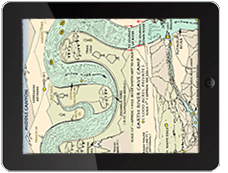Futaleufu, Library
The sound and the fury
NATIONAL GEOGRAPHIC ADVENTURE
Futaleuf River Rafting, Patagonia, Chile
March, 2016
By Maryellen Kennedy Duckett
Thundering out of the Andes and across Patagonia is one the world’s last great white-water wilderness rivers: Chile’s Futaleufú, or Fu. The Fu’s clear turquoise-to-teal waters rumble more than 120 miles through Chile. Each bend in the river seems to reveal a new awe-inspiring vista—steep canyon walls, giant granite boulders, Andean glaciers, snowcapped mountains, and primeval forests. The 47 rapids on the Fu range from easy Class II to extremely challenging Class V. Early spring marks the close of rafting season (December to mid-April), making now one of the last opportunities to experience the Futaleufú in 2016. “March is actually an excellent time to do the Futaleufú [pronounced Foo-tah-lay-oo-FOO], with stable weather and excellent water levels,” says Earth River Expeditions founder and owner Eric Hertz, who pioneered conservation awareness and commercial rafting trips on the river in the early 1990s. “Our most popular month is December with the holidays, but actually the weather's typically better in March than in December.”
WHERE: The Futaleufú River is located in northern Patagonia, originating in Argentina’s Amutui Quimey Lake and flowing west through Chile to the Pacific. The gateway to Futaleufú rafting is Puerto Montt, commercial and transportation hub of Chilean Patagonia. The closest international airport is in Santiago. From there, the flight takes an hour and 45 minutes to get to Puerto Montt.
HOW: Call Earth River to book a private (minimum six people, March - April) multisport river trip. Itineraries are customized to accommodate different fitness levels, rafting experience, and ages (six and older). All the rapids and activities such as mountain biking, rappelling, and horseback riding are optional. The ten-day lodge-to-lodge expedition begins in Puerto Varas (about ten miles north of Puerto Montt) and continues down the river. Day four (the first day on the water) begins with raft-safety training. Two safety catarafts (twin-hulled rafts) escort groups during all river portions of the trip.
STAY: Rates include lodging, which begins at the Hotel Cumbres Puerto Varas, where every guest room has a view of Lago Llanquihue and the snowcapped, Mount Fuji-like volcano Osorno. Remaining nights are spent at intimate wilderness properties, including the lakeshore cabins at Yelcho en la Patagonia; Tineo Patagonia ecolodge; and Uman Lodge, a remote cliff-top retreat perched 500 feet above the upper Futaleufú Valley.
EAT: Earth River expeditions include daily lunches at a local restaurant or remote picnic site, such as on the banks of a stunning waterfall swimming hole. Also included are daily chef-prepared breakfasts and dinners served at the lodges. One of the most popular dishes prepared on trips is Chilean asado, spit-barbecued lamb roasted slowly over an open fire.
FUN FACT: Near its source in Argentina, the Futaleufú River is dammed to produce hydroelectric power. Once the water clears the dam, it is free-flowing through Chile to the Pacific. To prevent similar construction and other unsustainable development on the Chilean portion of the Fu, Earth River Expeditions created a trust to purchase large chunks of land along the river.
The Robb Report Collection
June 2013
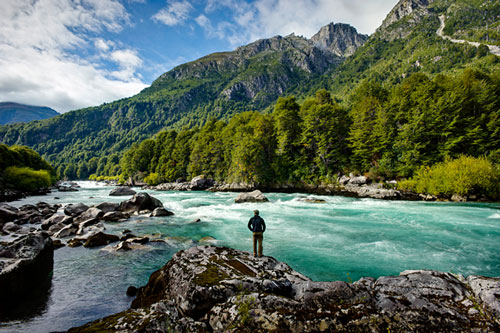
Patagonia's greatest whitewater adventure
By Shaun Tolson
The Futaleufu River’s Terminador Rapid can be heard surging from a quarter of a mile away. The class 5 stretch of whitewater cascades over and around imposing granite boulders for eight-tenths of a mile, and it lives up to its name. The river which runs more than 120 miles through Chile, drops 3,000 feet from beginning to end, and through its most challenging section of rapids the Futaleufu drops 45 feet per mile --33 feet more per mile than the Colorado River when it passes through the Grand Canyon. In Patagonia, which emerged as a world-class whitewater destination a little less than three decades ago, the Futaleufu is the crown Jewel.
A group of kayakers first negotiated the Futaleufu’s rapids in 1986, and the following year a commercial rafting company from the United States attempted to duplicate the effort. Prior to that attempt, The Terminador and other rapids along the river were unnamed, but that was about to change. Outfitted with large, traditional heavy rafts full of gear and rafters without paddles, the American company successfully traversed a handful of class 5 rapids before reaching the stretch of whitewater that--based on the impending result-- would come to be named Terminador. The rapid offers no margin of error, and the raft, weighed down by gear and without the help of passenger's paddling, drifted from the necessary line down the left side of the river. Instead, it was pulled down the center of the rapid, where it was trapped (and subsequently destroyed) in a large, violent hole--the section of a rapid below a submerged boulder where the resulting waterfall creates a backward--falling wave of equal strength. All of the rafters survived, but news of the event quickly circulated throughout the international rafting community and for years the Futaleufu was deemed unraftable. It wasn’t until 1991 that Eric Hertz and his company, Earth River Expeditions, decided to explore the possibilities.
Raft the Futaleufú River
National Geographic Adventure
February 2013
No self-respecting whitewater aficionado would contest that the Futaleufú is among the greatest stretches of whitewater on the planet. For about 50 miles, this shifting thread of turquoise winds through an impossibly grand theater of scenery. Rafters take in skyscraping peaks, sheer granite cliffs, and thickets of hardwood forest as they tumble down 36 Class IV and V rapids. Despite its brawn, however, the river is gravely endangered.
A Spanish power company, Endesa, has the rights to build three dams that would destroy long-standing shepherd communities and wipe out whitewater recreation forever. Earth River Expeditions, the whitewater-rafting company that pioneered the first raft descent of the river in 1991, has and continues to put up a massive fight. They bought a large amount of land that Endesa would have to purchase in order to build the dams and fought the construction of unsustainable development. In 2012, with the profits from their raft trips, they also founded a conservation organization, the Futaleufú Riverkeeper, to work on litigation, community outreach, and other conservation efforts full time.
The first thing travelers can do to support river conservation is experience the Fu. After cruising the river each day, rafters retire to camps etched into cliffs and perched in trees. Extracurricular activities include hot-tubbing in natural springs, rock climbing, rappelling, mountain biking, and, naturally, blissing out on a private beach. All profits from the trip go toward protecting the river. Want to do more? Donate directly to the Futaleufú Riverkeeper.
Outside Magazine
"Fu Fighters"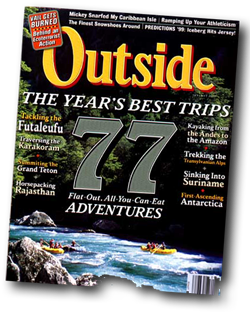
By David Rakoff
GLEN CLOSE AND I ARE HEAD OVER HEELS. Ass over teakettle we tumble from our raft into the spin cycle of the Rio Futaleufu. It is the perfect day; the sun is shining and the river is beautiful - a shimmering, effervescent foam that glits like a shower of sapphires as it closes over my head. suddenly I'm hit with a preconscious instinct, my own reverse Elephant Man moment. I am not a man, I am an animal: Follow the bubbles to the surface!
American Way
Fighting the Fu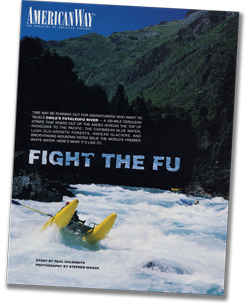
By Paul Goldsmith
American Airlines Magazine
Time may be running out for adventurers who want to tackle Chile's Futaleufu River - A 100-mile cerulean stripe that roars out of the Andes across the top of Patagonia to the Pacific. The Caribbean blue water, lush old-growth forests, Andean glaciers, and breathtaking mountain vistas belie the world's premier white water. Here's what it's like to fight the Fu.
A giant gray-green wave bears down on the boat, The bow of our 18-foot canary yellow inflatable raft dips as the wave crashes over us, and I feel the icy water run down my arms and chest inside my waterproof jacket. (I forgot to close the neck again - damn!) The water roars like a thousand TVs with the cable out. I shiver and shake my head to clear my eyes. Next to me Roger, is doing the same. Behind me in the boat I can hear John shouting encouragement to the other five people in the boat, but another wave is staring down at us. The bow dips in its now familiar pattern, and I'm already ducking my head. For seconds, I see only white froth before the boat explodes out over the wave, and then all I can see is sunlight.
Organic Connections Magazine
Fed by lakes high in the Andes of Argentina, the Rio Futaleufú crosses the Andes—and into Patagonia, Chile—before it finally empties into Yelcho Lake. Along its journey, it creates some of the most breathtaking scenery and whitewater experience to be found in the world. Unfortunately at the same time it is a potential resource for hydroelectric power that governments and power companies find completely irresistible.
For the moment—and hopefully well into the future—the river is being preserved through the efforts of whitewater experts Eric Hertz and Robert Currie, who have created a Land Trust and have facilitated the private purchases of key properties along the river that provide solid political resistance to its damming and any other adverse development. Through their company Earth River Expeditions, some of these purchases have also allowed Hertz and Currie to create a totally unique experience for visitors from all over the world.
Escape Magazine
"Rafting Rush in Patagonia"
By Rob Mcfarland
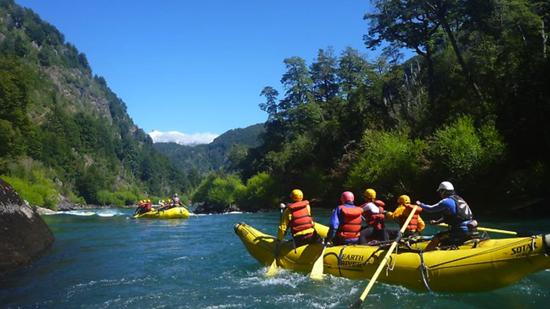
White water ride to Chile
Starting in Argentina, winding through the Andes to Chile, join Rob McFarland on the Futaleufu River for a dream rafting trip.
"PAY attention," shouts Pedro from the back of the raft. Six panting heads snap around in unison. We've failed to make it to the exit on the left side of the rapid so after some furious back-paddling we're now in an eddy on the more dangerous right side. It's time for Plan B. In front of us the river roars between two hulking granite boulders and there's just enough space for our raft.
"Ready?" asks Pedro. We nod. Forward paddle. We launch back into the main flow and are catapulted towards the right boulder. Commands come in quick succession: Left back ... right back ... all forward and we dig our paddles into the bracing, teal-coloured water. The boulders whiz by in a blur of grey and we're spat out into the calmer waters below. Exhausted, I turn around to see Pedro grinning. "Good job," he says, his deep, infectious laugh echoing off the sheer rock walls.
First ascent of the tower of the wind
(short story)
by Eric Hertz
Late one April after the rafting season, I was at Cave Camp building a trail around Laguito Azul to Lost Beach with the caretaker of the camp, Checho Berrera. The camp got its name from the massive rock shelter on the property. At one time the Puehenche Indians lived in this natural stone house which had a natural fireplace and was large enough to ride a horse inside.
My company, Earth River Expeditions, had been using the Camp for three seasons and yet the top of a 300 foot granite monolith that rose straight out of Laguito Azul and could be seen from everywhere in the camp remained a mystery.
Travels along the edge
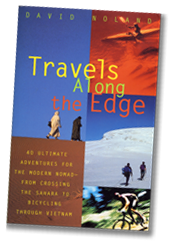 "Rafting the Futaleufu"
"Rafting the Futaleufu"
By David Noland (book chapter)
One day in 1989, as Eric Hertz's rented Toyota van bucked along a dirt road through the remote mountains of southern Chile, he looked down from a bridge and was what appeared to be a narrow tongue of the Caribbean Sea, a ribbon on bright aquamarine blue foaming with whitecaps.
Hertz, the owner of a small whitewater rafting company called Earth River Expeditions, had paddled down wild and scenic rivers all over the world, but he'd never seen anything like this. He stopped the van, walked over to the railing, and stared down at the rushing water. “I knew in an instant that this was the most beautiful river I'd ever seen.” Hertz recalls. “No other river has ever affected me like that. Not the Colorado, not even the Bio Bio. It was like God had designed the perfect whitewater river and laid it at my feet.”
Boston Globe
"On the Wild Side of Chile"
By Peter May
FUTALEUFU, Chile—So, my neighbor said, you really should come along. It's summer down there in February and this river is supposed to be beautiful.Chile? Yeah, right. That'll happen. Rafting? On a real river whose name I can't pronounce which has sharp rocks and big rapids? I don't think so. But, of course, it did happen. I'm here to report that I survived my first white-water rafting adventure—thanks to my swimming ability. I'm also here to report that if I can do it, just about anyone else can, and that I'd do it again. My neighbor had predicted this reaction. You'll come back a convert, he assured me. You'll be looking for the next big river now that you're a Class 5 guy.
New York Times
In Remote Chile, a Paradise Carved by White Water

The white-water outfitter Eric Hertz spent a lifetime searching for the perfect river. In 1990, he finally found it, in Patagonia. Intrepid kayakers who had ventured into southern Chile the previous year said that the Futaleufú River could not be rafted. But Hertz figured out how to safely navigate what today is the most intensive stretch of commercially rafted white-water rapids in the world. The company began protecting the shoreline and have turned the Fu into an outstanding adventure destination for rafters and kayakers.
Outside Kids
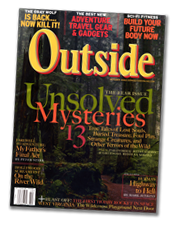 "Save the Fu"
"Save the Fu"
By Barclay Satterfield
We all put a drop of water on the back of our necks, for luck. Beth, one of the river guides, shouted “Remen a delante!” (Spanish for “paddle forward”), and we launched our raft into the rapids of the wild and phosphorescent green waters of Chile's Futaleufu (also called the Fu).
I had traveled from Smyrna, Delaware, last spring to spend seven days with five classmates hiking, rock climbing, riding horses, and, of course, white-water rafting, all before the spectacular backdrop of the Andean rainforest. Accompanying us once we arrived were Suj ey and Katia, two girls from the nearby town of Futaleufu, Chile. It was one of the most incredible trips of my life. And certainly the most disturbing.
Copyright © 2020 Earth River Expeditions


